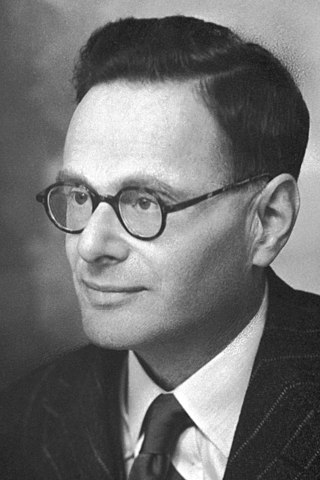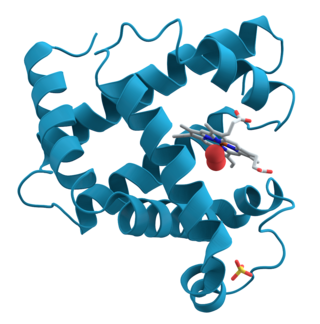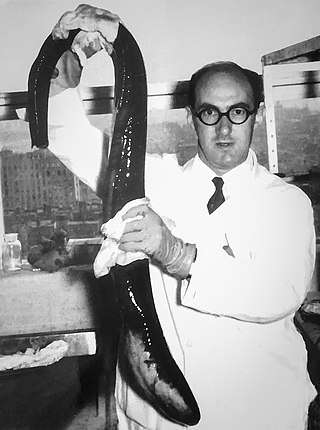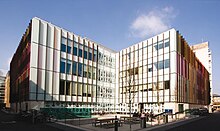
Dorothy Mary Crowfoot Hodgkin was a Nobel Prize-winning English chemist who advanced the technique of X-ray crystallography to determine the structure of biomolecules, which became essential for structural biology.

Sir Hans Adolf Krebs, FRS was a German-British biologist, physician and biochemist. He was a pioneer scientist in the study of cellular respiration, a biochemical process in living cells that extracts energy from food and oxygen and makes it available to drive the processes of life. He is best known for his discoveries of two important sequences of chemical reactions that take place in the cells of nearly all organisms, including humans, other than anaerobic microorganisms, namely the citric acid cycle and the urea cycle. The former, often eponymously known as the "Krebs cycle", is the sequence of metabolic reactions that allows cells of oxygen-respiring organisms to obtain far more ATP from the food they consume than anaerobic processes such as glycolysis can supply; and its discovery earned Krebs a Nobel Prize in Physiology or Medicine in 1953. With Hans Kornberg, he also discovered the glyoxylate cycle, a slight variation of the citric acid cycle found in plants, bacteria, protists, and fungi.

Fritz Albert Lipmann was a German-American biochemist and a co-discoverer in 1945 of coenzyme A. For this, together with other research on coenzyme A, he was awarded the Nobel Prize in Physiology or Medicine in 1953.

The Max Planck Institute for Biophysical Chemistry, also known as the Karl-Friedrich Bonhoeffer Institute, was a research institute of the Max Planck Society, located in Göttingen, Germany. On January 1, 2022, the institute merged with the Max Planck Institute for Experimental Medicine in Göttingen to form the Max Planck Institute for Multidisciplinary Sciences.

The Gottfried Wilhelm Leibniz Prize, or Leibniz Prize, is awarded by the German Research Foundation to "exceptional scientists and academics for their outstanding achievements in the field of research". Since 1986, up to ten prizes have been awarded annually to individuals or research groups working at a research institution in Germany or at a German research institution abroad. It is considered the most important research award in Germany.

Sir Hans Leo Kornberg, FRS was a British-American biochemist. He was Sir William Dunn Professor of Biochemistry in the University of Cambridge from 1975 to 1995, and Master of Christ's College, Cambridge from 1982 to 1995.

Norman Lowther Edson, FRSNZ, FNZIC, was the first Professor of Biochemistry (1949–1967) in the University of New Zealand based at the University of Otago, Dunedin, New Zealand where he founded a department of biochemistry. Edson made contributions to the understanding of ketone body metabolism in mammals and birds, metabolic pathways of Mycobacteria, and specificity rules for polyol dehydrogenases.

The history of biochemistry can be said to have started with the ancient Greeks who were interested in the composition and processes of life, although biochemistry as a specific scientific discipline has its beginning around the early 19th century. Some argued that the beginning of biochemistry may have been the discovery of the first enzyme, diastase, in 1833 by Anselme Payen, while others considered Eduard Buchner's first demonstration of a complex biochemical process alcoholic fermentation in cell-free extracts to be the birth of biochemistry. Some might also point to the influential work of Justus von Liebig from 1842, Animal chemistry, or, Organic chemistry in its applications to physiology and pathology, which presented a chemical theory of metabolism, or even earlier to the 18th century studies on fermentation and respiration by Antoine Lavoisier.
Joseph Stewart Fruton, born Joseph Fruchtgarten, was a Polish-American biochemist and historian of science. His most significant scientific work involved synthetic peptides and their interactions with proteases; with his wife Sofia Simmonds he also published an influential textbook, General Biochemistry. From 1970 until his death, Fruton worked extensively on the history of science, particularly the history of biochemistry and molecular biology.
Several universities have designed interdisciplinary courses with a focus on human biology at the undergraduate level. There is a wide variation in emphasis ranging from business, social studies, public policy, healthcare and pharmaceutical research.
Judith Patricia Armitage is a British molecular and cellular biochemist at the University of Oxford.

Faculty of Biology of the Belarusian State University was founded in 1931. It is a major biology research and teaching establishment in the country, which includes nine Departments and nine Research Laboratories. The Dean is Vadim Viktorovich Demidchyk, Docent, Doctor of Sciences

MSU Faculty of Biology is a faculty of Moscow State University, created in 1930. There are about 1500 employees, including over 100 professors, 140 associate professors and teachers, 700 research associates. The Faculty Dean is - Mikhail Kirpichnikov, a member of the Russian Academy of Sciences.

Mary Jane Osborn was an American biochemist and microbiologist known for her research on the biosynthesis of lipopolysaccharide, a key component of the outer membrane of Gram-negative bacteria, and discovering the mechanism of action of the anti-cancer drug methotrexate. She headed the Department of Molecular Biology and Biophysics at the University of Connecticut Health Center and served as president of the American Society for Biochemistry and Molecular Biology.
Rachel E. Klevit is professor of biochemistry, adjunct professor of chemistry, and adjunct professor of pharmacology at the University of Washington. She holds the Edmond H. Fischer-Washington Research Foundation Endowed Chair in Biochemistry. Klevit's research focuses on molecular interactions in human diseases and includes research on BRCA1, the protein ubiquitination system, and human heat shock proteins.

Mark Andrew Lemmon an English-born biochemist, is the Alfred Gilman Professor and Department Chair of Pharmacology at Yale University where he also directs the Cancer Biology Institute.
The Professorship of Genetics at the University of Oxford is a professorship that is attached to a fellowship at Keble College, Oxford. It was established in 1969 to address the relative lack of genetics available to undergraduate students at the university and has contributed to the development of genetics as an academic discipline there. The decision to create the position came at a time when notable geneticists at the university – the ecological geneticist Edmund Brisco Ford and the Sherardian Professor of Botany Cyril Darlington – had retired or were about to retire. The university created a lecturer and a demonstrator post in the discipline at the same time.
William Raymond Pearson is professor of biochemistry and molecular Genetics in the School of Medicine at the University of Virginia. Pearson is best known for the development of the FASTA format.

Ronald Whittam was an English research scientist in the field of cell physiology. He conducted important studies on the mechanism of active transport of ions across animal membranes and its relation to cellular metabolism. Whittam was the inaugural Chair in Physiology at the University of Leicester, where he was subsequently an Emeritus Professor.




















